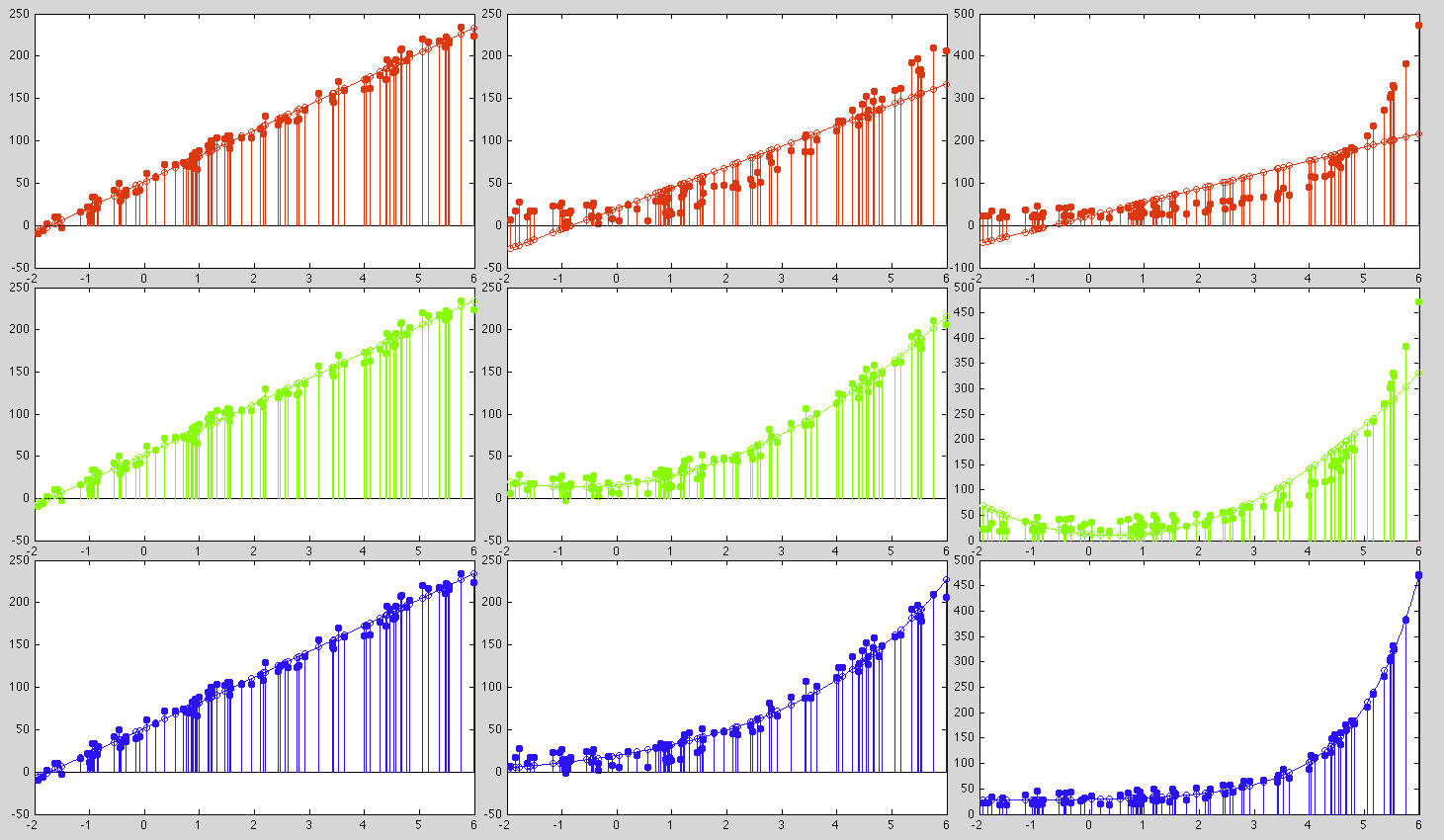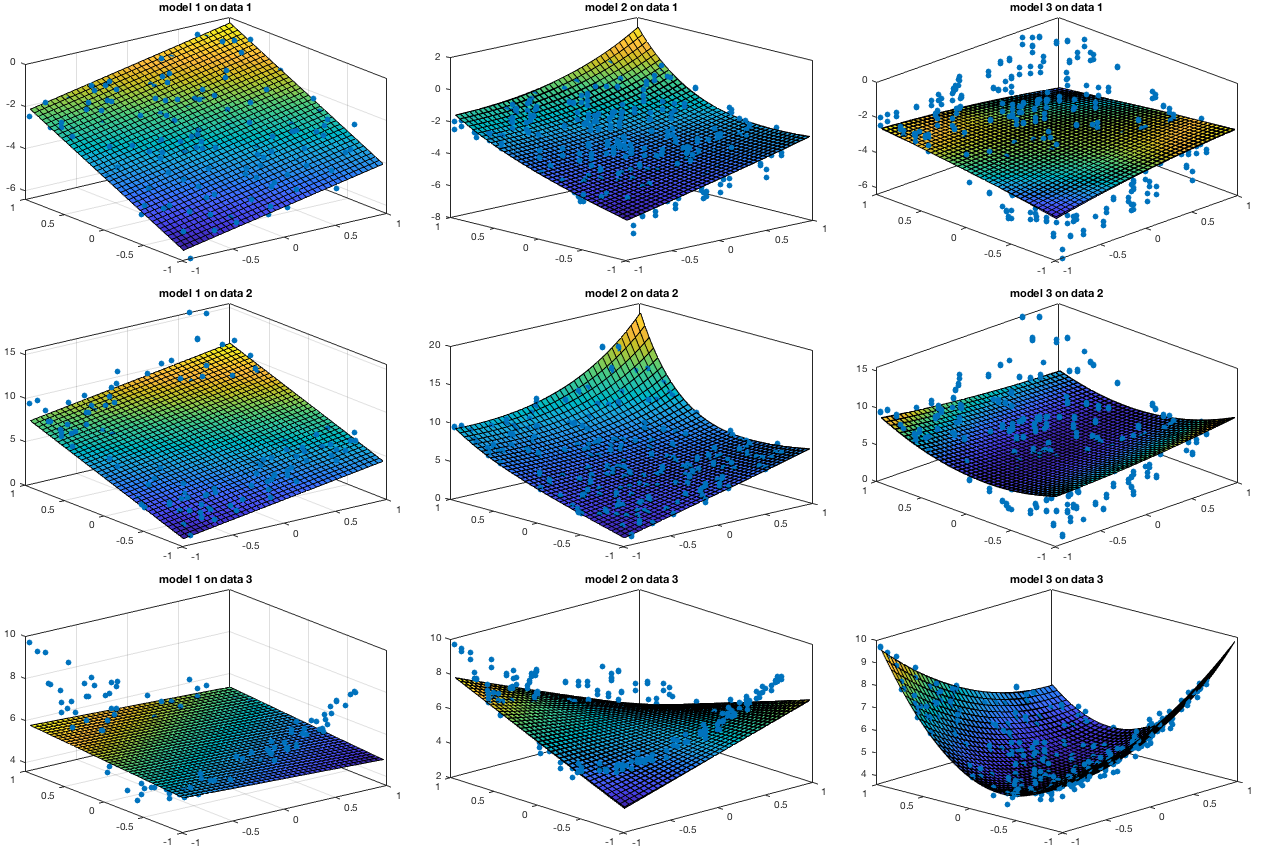Next: Logistic Regression and Binary Up: Regression Analysis and Classification Previous: Bayesian Linear Regression
The goal of nonlinear least squares (LS) regresion is to
model the nonlinear relationship between the dependent variable

![${\bf x}=[x_1,\cdots,x_d]^T$](img491.svg)


![${\bf\theta}=[\theta_1,\cdots,\theta_M]^T$](img501.svg)
 |
(187) |
 for the model to fit the
training dataset
for the model to fit the
training dataset  , so that, its output
, so that, its output
 matches the ground truth labeling
matches the ground truth labeling  in the training set,
i.e., the residual
in the training set,
i.e., the residual
 is ideally zero:
where
is ideally zero:
where
 is the predicted output by the regression function based on the
nth data point
is the predicted output by the regression function based on the
nth data point  . We see that the regression problem
is equivalent to solving a nonlinear equation system of
. We see that the regression problem
is equivalent to solving a nonlinear equation system of  equations for the
equations for the  unknown parameters in
unknown parameters in
 . As
typically there are many more data samples than the unknown
parameters, i.e.,
. As
typically there are many more data samples than the unknown
parameters, i.e.,  , the equation
, the equation
 is over-overconstrained without an exact solution. We therefore
consider the the optimal parameter
is over-overconstrained without an exact solution. We therefore
consider the the optimal parameter
 that minimizes
the sum-of-squared error based on the residual
that minimizes
the sum-of-squared error based on the residual  :
To do so, we first consider the gradient descent method based
on the gradient of this error function:
:
To do so, we first consider the gradient descent method based
on the gradient of this error function:
 is the
is the  Jacobian matrix
Jacobian matrix
 of
of
 . The mth component
of the gradient vector is
. The mth component
of the gradient vector is
 is
the element in the nth row and mth column of
is
the element in the nth row and mth column of  ,
which is simply the negative version of Jacobian of
,
which is simply the negative version of Jacobian of
 :
:
 |
(192) |
The optimal parameters in


 |
(193) |
 properly may
be tricky, as it depends on the specific landscape of the
error hypersurface
properly may
be tricky, as it depends on the specific landscape of the
error hypersurface
 . If
. If  is too large, a minimum may be skipped over, but if
is too large, a minimum may be skipped over, but if  is too large, the convergence of the iteration may be too
slow.
is too large, the convergence of the iteration may be too
slow.
This gradient method is also called
batch gradient descent (BGD), as the gradient in
Eq. (190) is calculated based on the entire batch
of all 



 |
(194) |
 based on one data point is
the same as the true gradient (scaled by
based on one data point is
the same as the true gradient (scaled by  ) based on
all
) based on
all  data points in the dataset
data points in the dataset
![$\displaystyle E[ {\bf g}_n({\bf\theta}) ]
=\sum_{n=1}^N P({\bf x}_n) {\bf g}_n(...
...{N}\sum_{n=1}^N \frac{dr_n}{d{\bf\theta}}\;r_n
=\frac{1}{N}{\bf g}({\bf\theta})$](img913.svg) |
(195) |
As the data are typically noisy, the SGD gradient based on
only one data point may be in a direction very different
from the true gradient based on the mean of all 
Some trade-off between BGD and SGD can be made so that the
gradient is estimated based on more than one but less than
all 
Alternatively, the optimal parameter



![[*]](crossref.png) ) in
Chapter 2:
) in
Chapter 2:
 .
Here
.
Here
 in the pseudo-inverse is actually an
approximation of the Hessian
in the pseudo-inverse is actually an
approximation of the Hessian
 of the error
function
of the error
function
 , as shown in the example
in a previous chapter,
and
, as shown in the example
in a previous chapter,
and
 is the gradient of the error function given in Eq. (190).
So the iteration above is essentially:
is the gradient of the error function given in Eq. (190).
So the iteration above is essentially:
 |
(197) |
 as the second order derivative of the error function
as the second order derivative of the error function
 is approximated by the Jacobian
is approximated by the Jacobian
 as the first order derivative of the
regression function
as the first order derivative of the
regression function
 , making
the implementation computationally easier.
, making
the implementation computationally easier.
In the special case of linear regression function

![$\displaystyle \hat{\bf y}={\bf f}({\bf X},{\bf w})
=\left[\begin{array}{c}f({\b...
...nd{array}\right]{\bf w}
=[{\bf x}_1,\cdots,{\bf x}_N]^T{\bf w}={\bf X}^T{\bf w}$](img925.svg) |
(198) |
![${\bf w}=[w_0,\,w_1,\cdots,w_d]^T$](img926.svg) and
and
![${\bf x}_i=[1, x_{i1},\cdots,x_{id}]^T$](img927.svg) are both augmented
are both augmented  dimensional vectors and
dimensional vectors and
![${\bf X}=[{\bf x}_1,\cdots,{\bf x}_N]$](img498.svg) .
The Taylor series is
.
The Taylor series is
 |
(199) |
 |
(200) |
 |
 |
 |
|
 |
 |
||
 |
 |
(201) |
 can be found in a single
step without iteration, same as that in Eq. (116).
can be found in a single
step without iteration, same as that in Eq. (116).
The Matlab code for the essential parts of the algorithm is
listed below, where data(:,1) and data(:,2) are the
observed data containing 


NLregression is called to estimate the
function parameters:
sym x; % symbolic variables
a=sym('a',[3 1]); % symbolic parameters
f=@(x,a)a(1)*exp(a(2)*x)+a(3)| % symbolic function
[a er]=NLregression(data(:,1),data(:,2),f,3); % call regression
The code below estimates the 
function [a er]=NLregression(x,y,f,M) % nonlinear regression
N=length(x); % number of data samples
a=sym('a',[M 1]); % M symbolic parameters
F=[];
for i=1:N
F=[F; f(x(i),a)]; % evaluate function at N given data points
end
J=jacobian(F,a); % symbolic Jacobian
J=matlabFunction(J); % convert to a true function
F=matlabFunction(F);
a1=ones(M,1); % initial guesses for M parameters
n=0; % iteration index
da=1;
while da>tol % terminate if no progress made
n=n+1;
a0=a1; % update parameters
J0=J(a0(1),a0(2)); % evaluate Jacobian based on a0
Jinv=pinv(J0); % pseudo inverse of Jacobian
r=y-F(a0(1),a0(2)); % residual
a1=a0+Jinv*r; % Newton iteration
er=norm(r); % residual error
da=norm(a0-a1); % progress
end
end
where tol is a small value for tollerance, such as  .
.
Example 1
Consider three sets of data (shown as the solid dots in the three columns in the plots below) are fitted by three different models (shown as the open circles in the plots):



These are the parameters for the three models to fit each of the three datasets:
 |
We see that the first dataset can be fitted by all three models equally
well with similar error (when


Example 2
Based on the following three functions with four parameters

 |
 |
 |
|
 |
 |
 |
|
 |
 |
 |
(202) |
Then each of three datasets are fitted by the three functions as models while the optimal parameters are found by the Gauss-Newton method.
 |

The Levenberg-Marquardt algorithm (LMA) or
damped least-squares method is a method widely
used to minimize a sum-of-squares error

Specifically, the LMA modifies Eq. (196)
![$\displaystyle {\bf\theta}_{n+1}={\bf\theta}_n
+{\bf J}^-_f({\bf\theta}_n)[ {\bf...
...\bf J}_n^T{\bf J}_n)^{-1}{\bf J}_n^T
[ {\bf y}-{\bf f}({\bf X},{\bf\theta}_n) ]$](img950.svg) |
(203) |
 :
where
:
where
 is the non-negative damping factor, which is to
be adjusted at each iteration. We recognize that this is actaully
similar to Eq. (144) for ridge regression.
is the non-negative damping factor, which is to
be adjusted at each iteration. We recognize that this is actaully
similar to Eq. (144) for ridge regression.
In each iterative step, if 






 |
(205) |
 is updated along the negative direction of
the gradient in Eq. (190):
is updated along the negative direction of
the gradient in Eq. (190):
 |
(206) |
 .
.
By adjusting the parameter 


